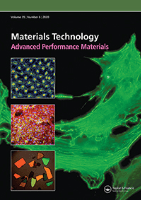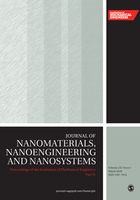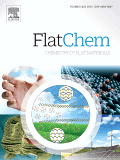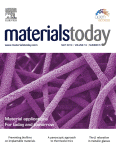
Digest Journal of Nanomaterials and Biostructures
metrics 2024
Connecting Science Through Nanomaterials and Biostructures
Introduction
The Digest Journal of Nanomaterials and Biostructures, published by VIRTUAL CO PHYSICS SRL, is a premier open-access journal since 2006, focusing on the dynamic intersections of nanotechnology, biostructures, and material science. Based in Romania, this journal caters to a diverse readership of researchers, professionals, and students in fields such as nanoscience, biomedical engineering, and condensed matter physics. Despite its current Q4 ranking in multiple categories, including Atomic and Molecular Physics and Structural Biology, the journal serves as a valuable platform for disseminating innovative research and fostering collaboration across scientific disciplines. The journal’s commitment to open access ensures that groundbreaking findings in nanomaterials are readily available to a global audience, reflecting the increasing importance of interdisciplinary research in addressing contemporary challenges. With its ongoing evolution and the potential for high-impact contributions to the scientific community, Digest Journal of Nanomaterials and Biostructures plays a crucial role in advancing knowledge and innovation in its respective fields.
Metrics 2024
 0.20
0.20 1.00
1.00 1.00
1.00 54
54Metrics History
Rank 2024
Scopus
IF (Web Of Science)
JCI (Web Of Science)
Quartile History
Similar Journals

MATERIALS TECHNOLOGY
Advancing the Frontiers of Materials ScienceMATERIALS TECHNOLOGY is a prestigious academic journal published by Taylor & Francis Ltd, based in the United Kingdom. With an ISSN of 1066-7857 and an E-ISSN of 1753-5557, this journal has established itself as a vital resource in the fields of Condensed Matter Physics, Materials Science, Mechanical Engineering, and Mechanics of Materials, earning a Q2 ranking in multiple categories as of 2023. With a rich publication history that dates back to the early 1970s, it serves as an essential platform for disseminating innovative research and developments in materials technology. Although not available through Open Access, the journal continues to attract contributions from leading researchers, ensuring high-quality articles that advance knowledge in the materials domain. The journal's commitment to excellence is reflected in its notable Scopus rankings, placing it within the 70th to 78th percentiles across several engineering and physics categories. As a vital resource for researchers, professionals, and students alike, MATERIALS TECHNOLOGY plays a critical role in shaping the future of materials science and engineering.

Proceedings of the Institution of Mechanical Engineers Part N-Journal of Nanomaterials Nanoengineering and Nanosystems
Shaping Tomorrow's Technologies through Nanomaterials ExplorationProceedings of the Institution of Mechanical Engineers Part N - Journal of Nanomaterials Nanoengineering and Nanosystems is a premier journal published by SAGE Publications Ltd that focuses on advancing the field of nanotechnology through high-quality research and critical review articles. With an ISSN of 2397-7914 and an E-ISSN of 2397-7922, this journal serves as a vital platform for researchers and industry professionals exploring the interdisciplinary applications of nanomaterials and nanoengineering. The journal has achieved a significant standing in the academic community, reflected in its Q3 ranking across multiple categories including Condensed Matter Physics, Electrical and Electronic Engineering, and Materials Science for 2023, positioning it within the 75th percentile in relevant fields. Covering topics that range from fundamental research to practical applications, the journal aims to disseminate findings that push the boundaries of materials science and engineering. With open access options available, it ensures that groundbreaking research is accessible to a global audience. The proceedings are published from 2016 to 2024 and are vital for anyone involved in the rapidly evolving domain of nanoscience.

ChemNanoMat
Exploring the Future of Nanoscale MaterialsChemNanoMat is a prestigious academic journal published by WILEY-V C H VERLAG GMBH, dedicated to the rapidly evolving fields of nanoscale materials and their applications in diverse areas such as biomaterials, energy engineering, and environmental sustainability. With the journal's ISSN 2199-692X and recognized quality, as evidenced by its Q2 rankings across multiple categories—including Biomaterials and Renewable Energy—ChemNanoMat serves as a crucial platform for researchers, professionals, and students to disseminate their findings and foster collaborations. Operating from Germany, the journal encourages the exploration of innovative materials solutions to meet tomorrow's challenges. While it does not currently offer open access options, it remains highly regarded in the academic community with a competitive impact factor that emphasizes its relevance and influence in guiding future research directions. Covering a broad scope from 2015 through 2024, ChemNanoMat is key for anyone invested in the advancement of materials chemistry and related scientific fields.

Accounts of Materials Research
Exploring innovative pathways in materials research.Accounts of Materials Research is a premier journal published by the American Chemical Society, focusing on the multidimensional field of materials science. With a robust impact factor and a commitment to open-access research, it serves as a vital platform for leading-edge discoveries from 2020 to 2024. The journal has rapidly ascended to the top quartile in multiple categories, including Chemical Engineering, Materials Chemistry, and Polymers and Plastics, demonstrating its significant influence within the academic community. Recognized by Scopus as a key resource—with remarkable rankings that place it in the 95th percentile of its field—Accounts of Materials Research is devoted to publishing high-quality, innovative research that addresses critical challenges in materials development and implementation. This journal is essential for researchers, professionals, and students seeking to stay informed about the latest advancements and collaborative opportunities within the interdisciplinary landscape of materials science.

FlatChem
Pioneering Breakthroughs in Ceramics and CompositesFlatChem, an esteemed journal published by ELSEVIER, serves as a premier platform for disseminating high-quality research in the dynamic fields of ceramic and composite materials, electronic and optical materials, materials chemistry, and surfaces, coatings, and films. Since its inception in 2017, the journal has garnered a robust reputation, evidenced by its rank in the top quartile (Q1) across multiple categories, including a commendable rank of #25/127 in Ceramics and Composites and #49/284 in Electronic, Optical and Magnetic Materials. With a focus on pioneering advancements and innovative methodologies, FlatChem not only highlights cutting-edge research but also promotes collaboration and knowledge exchange within the scientific community. The journal’s impact is underscored by its impressive rankings in Scopus, marking it as a vital resource for researchers, professionals, and students aiming to stay at the forefront of materials science. As an open-access journal, it ensures that groundbreaking findings are readily accessible, fostering a broader understanding and application of materials innovation worldwide. The journal is based in the Netherlands, with its headquarters located at RADARWEG 29, 1043 NX AMSTERDAM, NETHERLANDS. Join the vibrant community contributing to FlatChem and engage with the forefront of material advancements.

Materials Today
Pioneering Research for Tomorrow's TechnologiesMaterials Today is a premier academic journal published by Elsevier Science Ltd, specializing in the dynamic fields of materials science, mechanical engineering, and condensed matter physics. Established in 1999, the journal has garnered an enviable reputation, consistently ranking in the Q1 category across multiple disciplines including mechanics of materials and general materials science, reflecting its influence and high-quality research output. With an impressive Scopus ranking—4th in both mechanical engineering and mechanics of materials, and 6th in condensed matter physics—Materials Today serves as an essential resource for researchers, professionals, and students seeking to stay at the forefront of developments in material innovations and applications. The journal is known for its commitment to publishing significant research findings and reviews, making it a vital platform for disseminating knowledge and fostering collaboration in the rapidly evolving materials field. Although it does not offer open access, its robust impact factor underscores the importance of the content published, ensuring wide visibility and citation among the academic community. Explore the rich tapestry of materials research with Materials Today, where groundbreaking insights pave the way for future technological advancements.

Nano Materials Science
Unleashing Innovation in Materials Science.Nano Materials Science is a premier open-access journal dedicated to the dissemination of groundbreaking research in the fields of nanotechnology, materials science, and chemical engineering. Published by KEAI PUBLISHING LTD, this journal has quickly established itself as a leading platform in its area since its inception in 2019, with impressive rankings in the Scopus database, holding a Q1 position across multiple categories, including Chemical Engineering and Materials Science. Based in Beijing, China, Nano Materials Science provides researchers and practitioners access to a wealth of high-quality peer-reviewed articles, fostering innovation and collaboration within the scientific community. With its impact factor steadily rising and a commitment to open access, the journal aims to bridge the gap between theoretical research and practical applications, making it an essential resource for professionals and students eager to stay at the forefront of materials research and nanotechnology advancements.

FULLERENES NANOTUBES AND CARBON NANOSTRUCTURES
Elevating Knowledge in the World of NanostructuresFULLERENES NANOTUBES AND CARBON NANOSTRUCTURES, published by Taylor & Francis Inc, stands at the forefront of research in the fields of nanotechnology, materials science, and organic chemistry. With an ISSN of 1536-383X and an E-ISSN of 1536-4046, this journal offers a critical platform for disseminating significant findings related to carbon-based nanostructures, materials characterization, and their innovative applications. Recognized for its scholarly impact, the journal enjoys a Q2 ranking in several fields, including Atomic and Molecular Physics, Materials Science, and Organic Chemistry, reflecting its commitment to quality research. Since its inception in 2002, it has maintained a rigorous publication standard and provides open access options, enabling a diverse audience, from researchers to industry professionals, to engage with the latest advancements. The journal's comprehensive scope across converged years until 2024 emphasizes its pivotal role in fostering knowledge in the rapidly evolving realm of nanoscience and nanotechnology. Researchers and practitioners alike are encouraged to explore the cutting-edge research showcased in this vital resource.

Inorganics
Pioneering Open Access in Inorganic ChemistryInorganics is a vibrant, peer-reviewed Open Access journal dedicated to advancing the field of inorganic chemistry, published by MDPI since 2013. Based in Switzerland, this journal aims to provide a dynamic platform for researchers, professionals, and students to share groundbreaking findings, fostering collaboration and innovation within the global scientific community. With an impressive Q2 ranking in the category of Inorganic Chemistry as of 2023, Inorganics stands out as a significant conduit for high-quality research that spans a wide range of topics from coordination compounds to metal-organic frameworks. Its commitment to accessibility ensures that cutting-edge research can be accessed, utilized, and built upon by a diverse audience, thereby amplifying its impact. Join the conversation in Inorganics and contribute to the ever-evolving landscape of inorganic chemical research.

Small Methods
Pioneering new paths in nanotechnology and polymer science.Small Methods, published by WILEY-V C H VERLAG GMBH, is an esteemed peer-reviewed journal dedicated to advancing the fields of Chemistry and Materials Science. With a 2023 impact factor placing it in the Q1 category of both disciplines, and impressive Scopus rankings (27th in Materials Science and Chemistry), this journal serves as a vital platform for researchers and professionals alike to disseminate their innovative methodologies and pioneering experiments. Spanning a wide array of topics from nanotechnology to polymer science, Small Methods encourages the submission of high-quality research that illustrates novel small-scale methods applicable in various scientific contexts. Despite its absence of Open Access options, the journal is highly regarded for its rigorous editorial standards and comprehensive peer-review process, making it indispensable for students and academics aiming to stay at the forefront of these dynamic fields. With convergence years from 2017 to 2024, Small Methods continues to define the intersection of methodological innovation and practical application in both chemistry and material sciences.